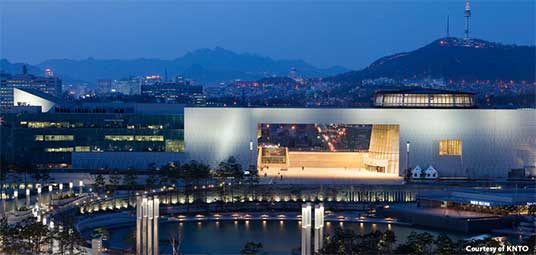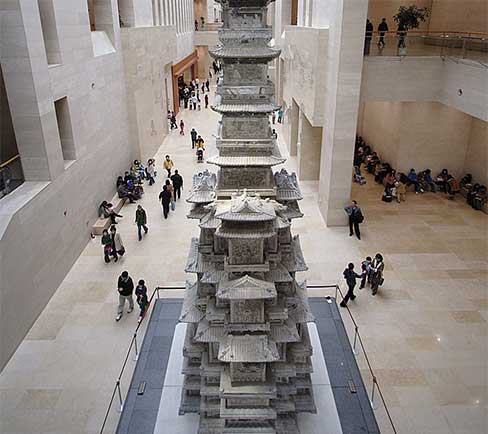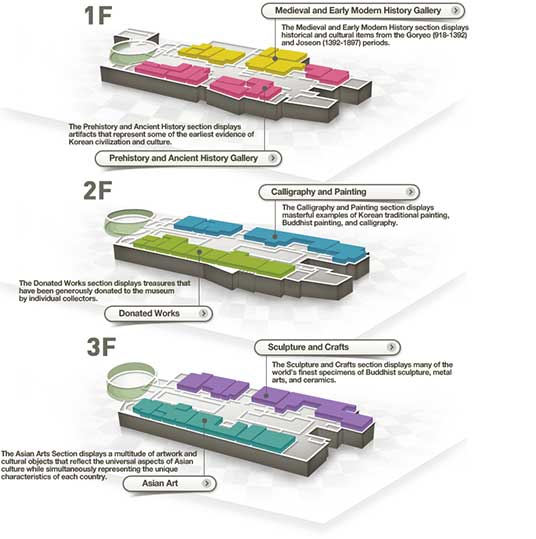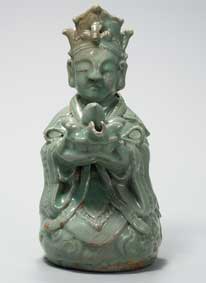
National Museum of Korea
The National Museum of Korea is the flagship museum of Korean history and art in South Korea and is the cultural organization that represents Korea. Since its establishment in 1945,the museum has been committed to various studies and research activities in the fields of archaeology, history, and art, continuously developing a variety of exhibitions and education programs.
In 2012, it was reported that since its relocation to Yongsan District in 2005, the Museum has attracted an attendance of 20 million visitors.A poll of nearly 2,000 foreign visitors, conducted by the Seoul Metropolitan Government in November 2011, stated that visiting the Museum is one of their favorite activities in Seoul.Lay out
The museum is divided into three floors. Symbolically, the left of the museum is supposed to represent the past, while the right side of the museum represents the future. The ground floor contains parks; gardens of indigenous plants; waterfalls and pools; and a collection of pagodas, stupas, lanterns, and steles (including National Treasure of Korea No. 2, the Great Bell of Bosingak, the exemplar of Korean bells of the Joseon period).
First floor
On the first floor is the Prehistory and Ancient History Gallery, which contains approximately 4,500 artifacts from the Paleolithic to the Unified Silla era excavated from sites across Korea. The nine exhibition rooms in the gallery are the Palaeolithic Room, the Neolithic Room, the Bronze Age & Gojoseon Room, the Proto Three Kingdoms Room, the Goguryeo Room, the Baekje Room, the Gaya Room, and the Silla Room. Ranging from chipped stone handaxes to luxurious ancient royal ornaments, the relics displayed here show a long journey taken by the early settlers on the Peninsula towards developing their own unique culture. Artifacts from important prehistoric sites and settlements such the Bangudae Petroglyphs and Songgung-ni are found in the Neolithic and Bronze Age Rooms. Also on the first floor is the Medieval and Early Modern History Gallery, which showcases the cultural and historical heritage throughout the Unified Silla, Balhae, Goryeo, and Joseon periods. The eight rooms of the gallery include the Unified Silla Room, Balhae Room, Goryeo Room, and the Joseon Room.
Second floor
The second floor contains the Donation Gallery and the Calligraphy and Painting Gallery, which contains 890 pieces of art that showcase the traditional and religious arts of Korea in line and color. The Calligraphy and Painting Gallery is divided into four rooms: the Painting Room, the Calligraphy Room, the Buddhist Paintings Room, and the Sarangbang(Scholar's Studio). The Donation Gallery holds 800 pieces of art donated from the private collections of collectors. The gallery is divided into eleven rooms: the Lee Hong-kun Collection Room, the Kim Chong-hak Collection Room, the Yu Kang-yul Collection Room, the Park Young-sook Collection Room, the Choi Young-do Collection Room, the Park Byong-rae Collection Room, the Yoo Chang-jong Collection Room, the Kaneko Kazushige Collection Room, the Hachiuma Tadasu Collection Room, the Iuchi Isao Collection Room, and the Other Collection Room.
Third floor
The third floor contains the Sculpture and Crafts Gallery, with 630 pieces that represent Korean Buddhist sculpture and craftwork. Highlights of the gallery include Goryeo Celadon wares and National Treasure of Korea No. 83, Bangasayusang (or Pensive Bodhisattva). The five rooms of the gallery are the Metal Arts Room, the Celadon Room, the Buncheong Ware Room, the White Porcelain Room, and the Buddhist Sculpture Room. Also on the third floor is the Asian Arts Gallery, which contains 970 pieces that explore the similarities and divergences of Asian art and the confluence of Asian and Western art via the Silk Road. The five rooms are the Indian & Southeast Asian Art Room, the Central Asian Art Room, the Chinese Art Room, the Sinan Undersea Relics Room, and the Japanese Art Room.
Information
1.Address: 37 Seobinggo-ro, Yongsan-gu, Seoul, 140-026, Korea
2.Admission charge: Free to Permanent Exhibition & Children’s Museum, except for special exhibitions
3.Transportation
Bus: (Blue) 502, (Green) 0018
Seoul Subway:Ichon Station (Exit 2), (Station #430 on Line 4, Station #K111 on Jungang Line)
Seoul City tour bus: City circulation course (station. National Museum of Korea)




